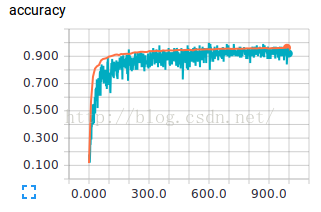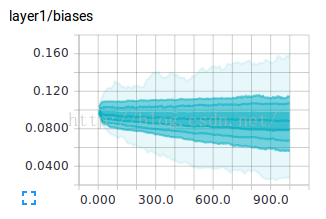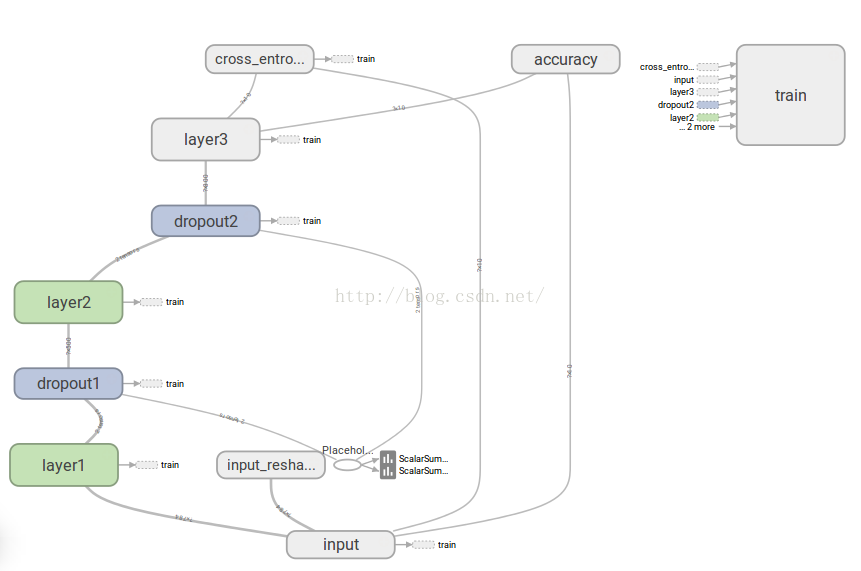比之前的例子更加庞大,使用全连接识别MNIST,需要命名空间更多,程序更灵活,但基本的函数换是那些。
- from __future__ import absolute_import
- from __future__ import division
- from __future__ import print_function
- import tensorflow as tf
- from tensorflow.examples.tutorials.mnist import input_data
- flags = tf.app.flags
- FLAGS = flags.FLAGS
- flags.DEFINE_boolean('fake_data', False, 'If true, uses fake data '
- 'for unit testing.')
- flags.DEFINE_integer('max_steps', 1000, 'Number of steps to run trainer.')
- flags.DEFINE_float('learning_rate', 0.001, 'Initial learning rate.')
- flags.DEFINE_float('dropout', 0.5, 'Keep probability for training dropout.')
- flags.DEFINE_string('data_dir', '/tmp/data', 'Directory for storing data')
- flags.DEFINE_string('summaries_dir', '/tmp/mnist_logs', 'Summaries directory')
- # Import data
- mnist = input_data.read_data_sets(FLAGS.data_dir,one_hot=True,fake_data=FLAGS.fake_data)
- sess = tf.InteractiveSession()
- # We can't initialize these variables to 0 - the network will get stuck.
- def weight_variable(shape):
- """Create a weight variable with appropriate initialization."""
- initial = tf.truncated_normal(shape, stddev=0.1)
- return tf.Variable(initial)
- def bias_variable(shape):
- """Create a bias variable with appropriate initialization."""
- initial = tf.constant(0.1, shape=shape)
- return tf.Variable(initial)
- def variable_summaries(var, name):
- """Attach a lot of summaries to a Tensor."""
- with tf.name_scope('summaries'):
- mean = tf.reduce_mean(var)
- tf.scalar_summary('mean/' + name, mean)
- with tf.name_scope('stddev'):
- stddev = tf.sqrt(tf.reduce_sum(tf.square(var - mean)))
- tf.scalar_summary('sttdev/' + name, stddev)
- tf.scalar_summary('max/' + name, tf.reduce_max(var))
- tf.scalar_summary('min/' + name, tf.reduce_min(var))
- tf.histogram_summary(name, var)
- def nn_layer(input_tensor, input_dim, output_dim, layer_name, act=tf.nn.relu):
- with tf.name_scope(layer_name):
- # This Variable will hold the state of the weights for the layer
- with tf.name_scope('weights'):
- weights = weight_variable([input_dim, output_dim])
- variable_summaries(weights, layer_name + '/weights')
- with tf.name_scope('biases'):
- biases = bias_variable([output_dim])
- variable_summaries(biases, layer_name + '/biases')
- with tf.name_scope('Wx_plus_b'):
- preactivate = tf.matmul(input_tensor, weights) + biases
- tf.histogram_summary(layer_name + '/pre_activations', preactivate)
- activations = act(preactivate, 'activation')
- tf.histogram_summary(layer_name + '/activations', activations)
- return activations
- # Input placehoolders
- with tf.name_scope('input'):
- x = tf.placeholder(tf.float32, [None, 784], name='x-input')
- y_ = tf.placeholder(tf.float32, [None, 10], name='y-input')
- keep_prob = tf.placeholder(tf.float32)
- def feed_dict(train):
- """Make a TensorFlow feed_dict: maps data onto Tensor placeholders."""
- if train or FLAGS.fake_data:
- xs, ys = mnist.train.next_batch(100, fake_data=FLAGS.fake_data)
- k = FLAGS.dropout
- else:
- xs, ys = mnist.test.images, mnist.test.labels
- k = 1.0
- return {x: xs, y_: ys, keep_prob: k}
- def train():
- with tf.name_scope('input_reshape'):
- image_shaped_input = tf.reshape(x, [-1, 28, 28, 1])
- tf.image_summary('input', image_shaped_input, 10)
- hidden1 = nn_layer(x, 784, 500, 'layer1')
- with tf.name_scope('dropout1'):
- tf.scalar_summary('dropout_keep_probability1', keep_prob)
- dropped1 = tf.nn.dropout(hidden1, keep_prob)
- hidden2 = nn_layer(dropped1, 500, 300, 'layer2')
- with tf.name_scope('dropout2'):
- tf.scalar_summary('dropout_keep_probability2', keep_prob)
- dropped2 = tf.nn.dropout(hidden2, keep_prob)
- y = nn_layer(dropped2, 300, 10, 'layer3', act=tf.nn.softmax)
- with tf.name_scope('cross_entropy'):
- diff = y_ * tf.log(y)
- with tf.name_scope('total'):
- cross_entropy = -tf.reduce_mean(diff)
- tf.scalar_summary('cross entropy', cross_entropy)
- with tf.name_scope('train'):
- train_step = tf.train.AdamOptimizer(FLAGS.learning_rate).minimize(
- cross_entropy)
- with tf.name_scope('accuracy'):
- with tf.name_scope('correct_prediction'):
- correct_prediction = tf.equal(tf.argmax(y, 1), tf.argmax(y_, 1))
- with tf.name_scope('accuracy'):
- accuracy = tf.reduce_mean(tf.cast(correct_prediction, tf.float32))
- tf.scalar_summary('accuracy', accuracy)
- # Merge all the summaries and write them out to /tmp/mnist_logs (by default)
- merged = tf.merge_all_summaries()
- train_writer = tf.train.SummaryWriter(FLAGS.summaries_dir + '/train',sess.graph)
- test_writer = tf.train.SummaryWriter(FLAGS.summaries_dir + '/test')
- tf.initialize_all_variables().run()
- #
- for i in range(FLAGS.max_steps):
- if i % 10 == 0: # Record summaries and test-set accuracy
- summary, acc = sess.run([merged, accuracy], feed_dict=feed_dict(False))
- test_writer.add_summary(summary, i)
- print('Accuracy at step %s: %s' % (i, acc))
- else: # Record train set summaries, and train
- summary, _ = sess.run([merged, train_step], feed_dict=feed_dict(True))
- train_writer.add_summary(summary, i)
- def main(_):
- if tf.gfile.Exists(FLAGS.summaries_dir):
- tf.gfile.DeleteRecursively(FLAGS.summaries_dir)
- tf.gfile.MakeDirs(FLAGS.summaries_dir)
- train()
- if __name__ == '__main__':
- tf.app.run()
- <span style="font-size:14px;">variable_summaries</span>
函数可以用在其他地方,打开目录定位/tmp/mnist_logs图表中可以有两条曲线,一个是是训练一个是测试


注意:如果保存数据过于频繁,会显著增加运行时间!毕竟硬盘读取的速度太慢,即使是SSD也不必要全部保存数据(程序速度能快一点是一点),一般的做法是每个100---1000步保存一下数据供图表显示即可。






 本文介绍了一个使用TensorFlow实现的全连接神经网络模型来识别MNIST手写数字数据集。该模型包括多个隐藏层,并使用了Dropout技术来防止过拟合。此外,还详细展示了如何设置超参数、构建模型、进行训练以及评估模型性能。
本文介绍了一个使用TensorFlow实现的全连接神经网络模型来识别MNIST手写数字数据集。该模型包括多个隐藏层,并使用了Dropout技术来防止过拟合。此外,还详细展示了如何设置超参数、构建模型、进行训练以及评估模型性能。
















 8826
8826

 被折叠的 条评论
为什么被折叠?
被折叠的 条评论
为什么被折叠?








